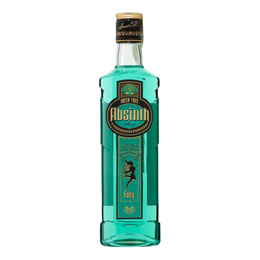Absinthe
Absinthe, with its bohemian character, is waiting for you to discover it!
Green Fairy Absinth 500ml
Frequently Asked Questions
01 What makes absinthe different from other drinks?
Absinthe stands out from other drinks because of its aromatic profile. The herbs used in the production of absinthe are responsible for its unique organoleptic character. Also, the alcoholic strength of this spirit is unusually high.
02 What is absinthe made of?
Absinthe is made from alcohol of agricultural origin, distilled in the presence of herbs. Without exception, artemisia, anise and fennel participate. Further herbs are added to the distillate, to achieve extraction of valuable constituents. The greenish color of absinthe is due to chlorophyll, which diffuses from the soaked herbs into the solution.
03 How are the taste and aroma of absinthe described?
When drinking absinthe straight, the alcohol sensation in the nose and the bitter sensation in the mouth overpower other elements. If the absinthe is diluted with water, then the herbal elements, present in the distillation, become clear. If a little sugar syrup is added to the mixture, then the bitter taste is mitigated.
04 What is the ideal occasion to enjoy an absinthe?
Absinthe, due to the herbs used in its production and due to its high alcohol content, is usually drunk during the cold season of the year. Gin lovers often alternate absinthe and gin between winter and summer, respectively.
05 Are there specific food recommendations that go well with absinthe?
An important component of absinthe is anise, also present in Greek ouzo. Just as ouzo goes well with seafood, so does absinthe. In fact, the combination is even better if seafood is smoked. The organoleptic pluralism of absinthe makes it able to stand next to white goat cheese, roquefort, pork or veal fillets, as well as fruit tarts. A nice sandwich with rye bread, salmon, arugula and avocado is ideally accompanied by a small glass of absinthe!
06 How can I store absinthe properly to preserve its flavor?
Keep absinthe away from sun and heat. It does not really matter if it is stored inside or outside the refrigerator.
07 Any suggestions on how to best serve absinthe?
According to tradition, a pony (about 30 mL) of absinthe is added to a small glass. A sugar cube is placed on a perforated spoon resting on the rim of the glass. Successive drops of water gradually dissolve the sugar, enriching the absinthe below. Absinthe, however, is becoming increasingly popular in cocktails. In Moulin Rouge, Archers Schnapps, absinthe and grenadine are mixed in a ratio of 4:2:1. In Green Tear, absinthe, cranberry juice and tonic are mixed in a ratio of 1:2:1.


